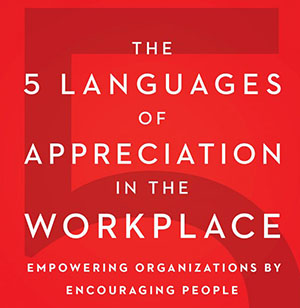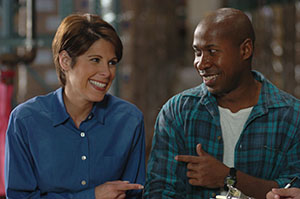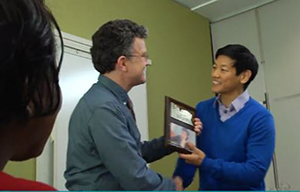The 5 Love Languages At Work

Every Employee Wants to Feel Appreciated
It’s been nearly two decades since Dr. Gary Chapman published his New York Times bestselling book The Five Love Languages. The premise is fairly straightforward: there are five ways people typically give and receive love, and because everyone experiences love differently, it’s easy to miss the mark when it comes to showing someone you care.
Since its publication, the book has helped millions improve their relationships with their significant others and loved ones… However, many have also found The 5 Love Languages® useful in navigating their professional relationships.
How Managers Can Use the Five Love Languages in the Workplace
Recently, Chapman partnered with Dr. Paul White to apply the concept of the love languages to the workplace. The two published The 5 Languages of Appreciation in the Workplace, aiming to help supervisors and managers effectively communicate appreciation and encouragement to their employees.
We’ve outlined the 5 Languages of Appreciation below:


Words of Affirmation
This language uses words (verbal or written) to affirm, appreciate, and acknowledge other people. Here are a few ways managers can cater to words of affirmation:
- Hand-writing a thank you note
- Taking the time to verbally recognize someone at the next team meeting
- Sending a meaningful email to an employee recognizing their hard work
Tip: For this language, the more specific the better. People want to know why they're doing a great job and how they’re appreciated. Challenge yourself to dig a little deeper!


Acts of Service
To speak Acts of Service means engaging in small acts that will help another person or make their job better, easier, or less stressful. Managers can use Acts of Service by:
- Helping their employees prioritize
- Offering to help or review an employee's work
- Providing a list of clear expectations and helpful resources at the start of every project
- If possible, offering to re-delegate tasks or projects
Tip: Understand scope of work! While the last thing we want you to do is micromanage, it is important for managers to understand what employees are working on and what it takes to get it done. Doing so allows you to set realistic expectations and demonstrate to your team that their hard work is valued.


Gifts
This language expresses appreciation through thoughtful gift-giving— i.e. sending someone something that says, “This made me think of you!” Managers can speak this language by:
- Picking up lunch for the team
- Forwarding useful tools and articles
- Giving small gifts around the holidays
Tip: Consider the employee! For example, some may appreciate more tangible gifts such as a bottle of wine they off-handedly mentioned as their favorite, while others may appreciate more experienced-based gifts such as more time off after working long hours or the ability to work from home.


Quality Time
Those who speak this language feel the most appreciated when given your full, undivided attention. Here are a few ways managers can demonstrate Quality Time:
- Schedule regular 1-on-1 meetings
- Make yourself available to answer employee questions or address concerns
- Set aside time for team-building activities and events (monthly team lunches, Friday walking meetings, etc.)
Tip: Allow your employees to run your 1-on-1’s before going into your own talking points. Listen to their updates, answer their questions, and make sure they’re getting everything they need.


Physical Touch
Physical contact at work is, in all aspects, a touchy subject. What constitutes “appropriate” largely depends on personal boundaries and cultural norms. Some employees might welcome a casual physical touch, like a congratulatory arm around their shoulders after a job well done. For others, it would be an invasion of their personal space. Bottom line: Always. Seek. Consent.
That said, given the rising awareness about combating sexual harassment in the workplace, some managers may believe that physical touch in the workplace is never a good idea. However, there are safe ways to use physical touch to show appreciation. Consider:
- A *firm, congratulatory handshake (*because no one likes a dead fish)
- A high-five or fist-bump
Tip: If you're uncomfortable physically touching your employees or unsure of how they might react, then play it safe and use one of the other 4 languages above instead.


Wait, but how will I know which language to use?
Now that you know how to use the 5 Languages of Appreciation, you may be wondering when to use them… Here’s a good rule of thumb: People typically appreciate others in the way they want to be appreciated.


All colleagues, clients, and customers are different, so the key to figuring out which language makes a person feel most valued is to simply pay attention.If you don’t feel comfortable asking people outright (which we 10/10 would recommend), start by trying out a few different tactics. Then take note of how each individual responds. Over time, the right appreciation language will reveal itself. People respond to all five languages, but 1 or 2 makes them feel most valued. So, if in doubt any appreciation is good.
For more on appreciation in the workplace, see this related post: Showing Appreciation - Training Activity
Recommended Training
Play the trailer.
The Practical Coach 2
is our best-selling program for teaching managers and supervisors how to recognize and appreciate employees.
Memorable scenes model practical coaching techniques during three critical times: When you observe GOOD work, POOR work, or DEAD END performance.
Visit the product page and
sign-up to watch the full preview.





